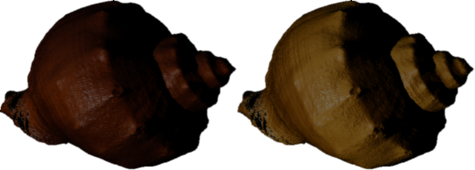Bidirectional Texture Function Simultaneous Autoregressive Model
Results
We have tested the BTF-SAR model algorithm on BTF colour textures from the University of Bonn BTF measurements (several available materials such
as leather, wood, wool). Each BTF material sample comprised in the University of Bonn database is measured in 81 illumination and 81 viewing angles and
has resolution 800 × 800 pixels, so that 81 × 81 images had to be analysed for each material. Following figures demonstrate the synthesised result for two different wood samples, i.e. synthesised BTF textures combined with their range maps in the displacement mapping filter of the rendering software (Blender) with the BTF pluggin and mapped to the detailed conch model measured using our Konika-Minolta laser scanner.

